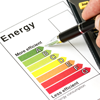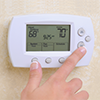Another month has come and gone and that means another electric bill is due. A good majority of us are guilty of just scrolling our eyes down to the bottom of the statement, only looking at the total amount due. We write out the check and then go on to open another bill. But how many times have you actually analyzed your electric bill and assessed your energy use for the month? Do you know which rooms of your home use the most energy or the time of day your energy consumption is at its peak? To help you answer those questions, most electric companies offer an in-home energy audit to help you save energy.
Energy Audit
 Home energy audits can be performed by your electric company or by a professional energy auditor. During your home checkup, the auditor will inspect your attic’s insulation, furnace and duct work, as well as look for any leaks. A blower door test and infrared camera might also be used to establish any areas where the home has an unintentional air passageway. After the audit, the auditor will be able to determine where your house could be more efficient and what can be corrected to help you save energy and money.
Home energy audits can be performed by your electric company or by a professional energy auditor. During your home checkup, the auditor will inspect your attic’s insulation, furnace and duct work, as well as look for any leaks. A blower door test and infrared camera might also be used to establish any areas where the home has an unintentional air passageway. After the audit, the auditor will be able to determine where your house could be more efficient and what can be corrected to help you save energy and money.
Energy Plan
 After the energy audit, you will be more aware of where the majority of your energy consumption is going and how to make any necessary changes to be more efficient. These proposed changes are simply recommendations made by the auditor, and are not required. However, by making the suggested efficiency upgrades, you could save 5 to 30 percent on your monthly energy bill.
After the energy audit, you will be more aware of where the majority of your energy consumption is going and how to make any necessary changes to be more efficient. These proposed changes are simply recommendations made by the auditor, and are not required. However, by making the suggested efficiency upgrades, you could save 5 to 30 percent on your monthly energy bill.
DIY Energy Assessment
 If your energy company does not offer an energy auditing service or you do not want to pay for a professional, you can perform an energy assessment on your own. You can check for air leaks caused by gaps around windows, doors, lighting fixtures, and electrical outlets, in addition to inspecting the insulation in your attic. A home energy assessment is just the beginning of your energy savings journey, and whether performed by a professional or done by yourself, it can help you be more conscious of where the majority of your energy is being consumed.
If your energy company does not offer an energy auditing service or you do not want to pay for a professional, you can perform an energy assessment on your own. You can check for air leaks caused by gaps around windows, doors, lighting fixtures, and electrical outlets, in addition to inspecting the insulation in your attic. A home energy assessment is just the beginning of your energy savings journey, and whether performed by a professional or done by yourself, it can help you be more conscious of where the majority of your energy is being consumed.
Become Energy Efficient
 So the next time you get your electric bill, take a look at your total energy consumption for the month. Consider contacting your electric company to see if an energy audit service is offered, and to identify how efficiently or inefficiently your home’s energy is being used.
So the next time you get your electric bill, take a look at your total energy consumption for the month. Consider contacting your electric company to see if an energy audit service is offered, and to identify how efficiently or inefficiently your home’s energy is being used.


 Before leaving your home, set aside some time to walk through your home and make sure all unnecessary electronics and appliances are unplugged. Although you may not be using them while you’re on your vacation,
Before leaving your home, set aside some time to walk through your home and make sure all unnecessary electronics and appliances are unplugged. Although you may not be using them while you’re on your vacation,  Unless there are pets in the house while you’re away on your summer vacation, you can really take advantage of increasing your thermostat to cut energy consumption. Setting your thermostat between 85 to 87 degrees will show a drop in your next energy bill.
Unless there are pets in the house while you’re away on your summer vacation, you can really take advantage of increasing your thermostat to cut energy consumption. Setting your thermostat between 85 to 87 degrees will show a drop in your next energy bill.  On longer summer trips, it is a good idea to clean out your refrigerator and turn it off. Refrigerators are a major culprit of using large amounts of energy; they are the Hummers of automobiles. If the trip is shorter, you can raise the refrigerator and freezer temperature to the highest temperature it can go without spoiling the food inside. You can also power down your water heater if your summer vacation is longer than just a weekend getaway. Before shutting down or adjusting the settings on any major appliance, be sure to read the product manual to avoid issues.
On longer summer trips, it is a good idea to clean out your refrigerator and turn it off. Refrigerators are a major culprit of using large amounts of energy; they are the Hummers of automobiles. If the trip is shorter, you can raise the refrigerator and freezer temperature to the highest temperature it can go without spoiling the food inside. You can also power down your water heater if your summer vacation is longer than just a weekend getaway. Before shutting down or adjusting the settings on any major appliance, be sure to read the product manual to avoid issues. There are many things you can do to save energy in your vacant home during your summer vacation. Besides unplugging and turning off different appliances, you can also do simple, yet effective tasks, like closing your blinds and curtains. This helps maintain your home’s temperature by blocking the heat so that your AC doesn’t run more frequently than necessary. If you have window film on your home’s windows, that will provide an additional layer of protection from the sun’s rays and also help prevent fading of your window coverings. Your home’s windows provide the easiest access for cool air to escape and warm air to enter. Covering your windows also provides a level of privacy while you are away. So on your next summer vacation, be sure to follow some of these energy saving tips so you can worry less about your bills and more about relaxation.
There are many things you can do to save energy in your vacant home during your summer vacation. Besides unplugging and turning off different appliances, you can also do simple, yet effective tasks, like closing your blinds and curtains. This helps maintain your home’s temperature by blocking the heat so that your AC doesn’t run more frequently than necessary. If you have window film on your home’s windows, that will provide an additional layer of protection from the sun’s rays and also help prevent fading of your window coverings. Your home’s windows provide the easiest access for cool air to escape and warm air to enter. Covering your windows also provides a level of privacy while you are away. So on your next summer vacation, be sure to follow some of these energy saving tips so you can worry less about your bills and more about relaxation. The biggest energy expenditure in any apartment is temperature control.
The biggest energy expenditure in any apartment is temperature control.  Often, annoying energy-wasting expenditures come at the margins of your life.
Often, annoying energy-wasting expenditures come at the margins of your life.  It can be easy to forget how hot or cold you’ve set the thermostat. But if you want to save energy, it’s so important that you know exactly how hot or cold you’re keeping your home. Buy a
It can be easy to forget how hot or cold you’ve set the thermostat. But if you want to save energy, it’s so important that you know exactly how hot or cold you’re keeping your home. Buy a  Basically, that would be the additional annual cost to U.S. viewers’ utility bills if everyone switched to UHD TVs without the energy-efficient bells and whistles. However, there are some UHD models, such as
Basically, that would be the additional annual cost to U.S. viewers’ utility bills if everyone switched to UHD TVs without the energy-efficient bells and whistles. However, there are some UHD models, such as  If you’re thinking about buying a UHD TV, the simplest thing you can do is buy an ENERGY STAR certified one. You can shop using filters on
If you’re thinking about buying a UHD TV, the simplest thing you can do is buy an ENERGY STAR certified one. You can shop using filters on  Cree’s new 9.5-watt LED Soft White looks just like a traditional bulb. It fits into standard-size outlets. And it operates just as a traditional bulb would – lights immediately in all directions and dims without buzzing. But it uses up to 84% less energy, which earned it the trusted
Cree’s new 9.5-watt LED Soft White looks just like a traditional bulb. It fits into standard-size outlets. And it operates just as a traditional bulb would – lights immediately in all directions and dims without buzzing. But it uses up to 84% less energy, which earned it the trusted 